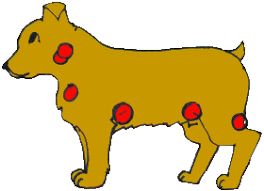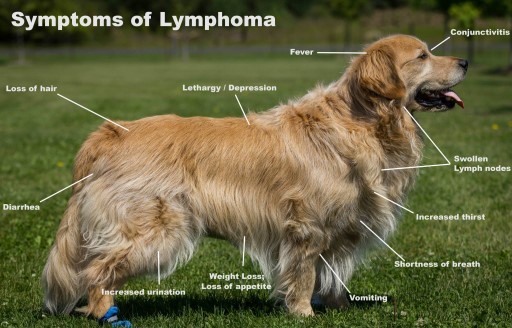

Spotlight on...Canine Lymphoma
What is lymphoma?
Lymphoma (also called Lymphosarcoma or Malignant Lymphoma) is one of the most common cancers which affects our dogs. The term lymphoma is used to describe a group of cancers that stem from the white blood cells (lymphocytes). These white blood cells play a key role in helping the immune system fight off infection. Lymphoma can affect any organ in the body, but is often found in organs such as the lymph nodes, the spleen, and bone marrow where there are high concentrations of lymphocytes. Dogs of all breeds and all ages may be affected, but this type of cancer most commonly affects middle aged dogs (dogs between 6 and 9 years of age). The most common forms of lymphoma in dogs are multicentric or generalised lymphoma, alimentary, mediastinal, and extranodal lymphoma.
Roughly 80-85 percent of lymphomas in dogs are multicentric or generalised. This cancer affects the lymph nodes which become suddenly enlarged. Alimentary lymphoma is the second most common form of lymphoma. Accounting for about 10 percent of canine lymphomas it targets the intestines. Mediastinal lymphoma is rare. This cancer affects the thymus and or mediastinal lymph nodes in the chest area. When lymphoma targets a specific organ of a dog (e.g. the skin, eyes, kidneys, lungs, or central nervous system) it is called extranodal lymphoma. This type of cancer most commonly affects the skin.
Lymphoma can also affect cats where it often presents in the internal organs. Cats that have been infected with either feline leukemia virus (FeLV) or feline immunodeficiency virus (FIV), have a significantly higher rate of lymphomas than the general cat population.
What are the signs and symptoms of lymphoma?
Just as there are different types of lymphoma, so the symptoms of lymphoma vary. Initially this can make it hard to reach a diagnosis. However, we need to watch out for the following symptoms:
Multicentric Lymphoma:
Swollen lymph nodes (up to 3 to 10 times their normal size)
Non-painful
Feels like a firm rubbery lump
Moves freely under the skin
Lethargy
Fever
Anorexia
Weakness
Dehydration
Alimentary Lymphoma:
Vomiting
Abdominal pain
Anorexia
Diarrhoea
Weight loss
Mediastinal Lymphoma:
Difficulty breathing
Swelling of the face or front legs
Increased thirst
Increased urination
Extranodal Lymphoma:
In this case the symptoms will depend on the organs affected. The most common organ affected by extranodal lymphoma is the skin (cutaneous lymphoma), which often manifests in raised nodules or scaly lesions, particularly around and within the mouth.
Looking out for these signs and symptoms can help us to recognise that our dogs may be affected by lymphoma, but sometimes this type of cancer develops with very few signs and is only discovered at a very late stage.
How is lymphoma diagnosed?
A definitive diagnosis is important for the proper treatment and prognosis of your dog. This begins with an evaluation of the clinical signs and taking a clinical history. Your veterinarian will probably also take a sample of the affected organ, often using a fine-needle aspiration or a biopsy. The sample will then be evaluated through histopathology and specialised staining. Additional tests, such as blood tests, urinalysis, x-rays, abdominal ultrasounds, and bone marrow aspiration may be required to give your veterinarian a complete picture of your dog's overall health and the progression of the disease. Together these tests help your veterinarian formulate the best approach to your dog's treatment in the light of their overall condition and the progression of the disease.
What treatments are available?
Treatment of lymphoma may involve chemotherapy, radiation therapy and or surgery depending on the type of cancer. Chemotherapy has proven most effective in the treatment of canine lymphoma, with the precise protocol used depending on the type of lymphoma. It is important to recognise that dogs respond differently to humans. Usually chemotherapy does not make dogs sick, and hair loss is rare, although certain breeds like Poodles, Old English Sheepdogs, and the Bichon Frise are more prone to this problem than others. Common side effects of chemotherapy in dogs include mild vomiting and diarrhoea, decreased appetite, and decreased activity levels. The protocols for treatment are carefully worked out to cause maximum damage to the cancer while limiting the possible side effects of the chemotherapy.
Besides treatment using chemotherapy, palliative care is also possible using non-cytotoxic drugs. In such cases remission is generally short (1-2 months).
Recently evidence has shown that your dog's diet can have an affect on lymphoma. By adjusting your dog's diet we can reduce the food available to the cancer cells. Speak to your vet about the available options.
How will treatment help this condition?
Lymphoma is an aggressive disease. Left untreated it is fatal. In cases of generalised or multicentic lymphoma the disease may prove fatal within a matter of weeks from the time of diagnosis.
The prognosis for your dog will depend on many factors such as what type of lymphoma is affecting them, the stage of the disease at the time of treatment, the treatment protocols employed, and your dog's overall health. With appropriate treatment it is often possible to maintain quality of life for an extended period of time (e.g. 6 months - 2 years). However, it is important to recognise that treatment rarely cures the disease. Most often it leads to remission, meaning that some or all of the signs and symptoms of cancer have, for the time being, disappeared. When signs and symptoms recur the cancer is often more difficult to treat. Eventually, the disease will prove fatal.
As an owner it is important for you to understand the treatment options and how the disease is likely to progress, and to take a proactive role in ensuring that your dog's treatment improves her quality of life.
Lymphoma is a complex disease. The goal of appropriate treatment is always to improve quality of life. Chemotherapy has proven to be an effective treatment with minimal side effects offering a good chance of long, disease free remission.
If you are worried your dog might have lymphoma, or if you have more questions about your dog's cancer, please call us at Southern Cross Veterinary Clinic and ask to speak to one of our vets.
What causes lymphoma in dogs?
There is still so much we don't know about cancer. Scientists currently do not know what causes lymphoma in dogs, but there is hope that advanced genetic studies will eventually help identify any underlying genetic and chromosomal causes and predispositions. What we do know is that dogs share our environment, and so they are exposed to many of the same cancer-causing environmental factors as we are.
Why has my dog developed lymphoma?
There are a few risk factors that have been identified, such as exposure to certain types of herbicide and a weak association with strong magnetic fields. With our increasing knowledge of molecular biology, we are beginning to identify some mutations and chromosomal abnormalities that are present in up to 40% of cases. However, most cases have no specific cause.
back to Pet Info
back to home
What is lymphoma?
Lymphoma (also called Lymphosarcoma or Malignant Lymphoma) is one of the most common cancers which affects our dogs. The term lymphoma is used to describe a group of cancers that stem from the white blood cells (lymphocytes). These white blood cells play a key role in helping the immune system fight off infection. Lymphoma can affect any organ in the body, but is often found in organs such as the lymph nodes, the spleen, and bone marrow where there are high concentrations of lymphocytes. Dogs of all breeds and all ages may be affected, but this type of cancer most commonly affects middle aged dogs (dogs between 6 and 9 years of age). The most common forms of lymphoma in dogs are multicentric or generalised lymphoma, alimentary, mediastinal, and extranodal lymphoma.
Roughly 80-85 percent of lymphomas in dogs are multicentric or generalised. This cancer affects the lymph nodes which become suddenly enlarged. Alimentary lymphoma is the second most common form of lymphoma. Accounting for about 10 percent of canine lymphomas it targets the intestines. Mediastinal lymphoma is rare. This cancer affects the thymus and or mediastinal lymph nodes in the chest area. When lymphoma targets a specific organ of a dog (e.g. the skin, eyes, kidneys, lungs, or central nervous system) it is called extranodal lymphoma. This type of cancer most commonly affects the skin.
Lymphoma can also affect cats where it often presents in the internal organs. Cats that have been infected with either feline leukemia virus (FeLV) or feline immunodeficiency virus (FIV), have a significantly higher rate of lymphomas than the general cat population.
What are the signs and symptoms of lymphoma?
Just as there are different types of lymphoma, so the symptoms of lymphoma vary. Initially this can make it hard to reach a diagnosis. However, we need to watch out for the following symptoms:
Multicentric Lymphoma:
Swollen lymph nodes (up to 3 to 10 times their normal size)
Non-painful
Feels like a firm rubbery lump
Moves freely under the skin
Lethargy
Fever
Anorexia
Weakness
Dehydration
Alimentary Lymphoma:
Vomiting
Abdominal pain
Anorexia
Diarrhoea
Weight loss
Mediastinal Lymphoma:
Difficulty breathing
Swelling of the face or front legs
Increased thirst
Increased urination
Extranodal Lymphoma:
In this case the symptoms will depend on the organs affected. The most common organ affected by extranodal lymphoma is the skin (cutaneous lymphoma), which often manifests in raised nodules or scaly lesions, particularly around and within the mouth.
Looking out for these signs and symptoms can help us to recognise that our dogs may be affected by lymphoma, but sometimes this type of cancer develops with very few signs and is only discovered at a very late stage.
How is lymphoma diagnosed?
A definitive diagnosis is important for the proper treatment and prognosis of your dog. This begins with an evaluation of the clinical signs and taking a clinical history. Your veterinarian will probably also take a sample of the affected organ, often using a fine-needle aspiration or a biopsy. The sample will then be evaluated through histopathology and specialised staining. Additional tests, such as blood tests, urinalysis, x-rays, abdominal ultrasounds, and bone marrow aspiration may be required to give your veterinarian a complete picture of your dog's overall health and the progression of the disease. Together these tests help your veterinarian formulate the best approach to your dog's treatment in the light of their overall condition and the progression of the disease.
What treatments are available?
Treatment of lymphoma may involve chemotherapy, radiation therapy and or surgery depending on the type of cancer. Chemotherapy has proven most effective in the treatment of canine lymphoma, with the precise protocol used depending on the type of lymphoma. It is important to recognise that dogs respond differently to humans. Usually chemotherapy does not make dogs sick, and hair loss is rare, although certain breeds like Poodles, Old English Sheepdogs, and the Bichon Frise are more prone to this problem than others. Common side effects of chemotherapy in dogs include mild vomiting and diarrhoea, decreased appetite, and decreased activity levels. The protocols for treatment are carefully worked out to cause maximum damage to the cancer while limiting the possible side effects of the chemotherapy.
Besides treatment using chemotherapy, palliative care is also possible using non-cytotoxic drugs. In such cases remission is generally short (1-2 months).
Recently evidence has shown that your dog's diet can have an affect on lymphoma. By adjusting your dog's diet we can reduce the food available to the cancer cells. Speak to your vet about the available options.
How will treatment help this condition?
Lymphoma is an aggressive disease. Left untreated it is fatal. In cases of generalised or multicentic lymphoma the disease may prove fatal within a matter of weeks from the time of diagnosis.
The prognosis for your dog will depend on many factors such as what type of lymphoma is affecting them, the stage of the disease at the time of treatment, the treatment protocols employed, and your dog's overall health. With appropriate treatment it is often possible to maintain quality of life for an extended period of time (e.g. 6 months - 2 years). However, it is important to recognise that treatment rarely cures the disease. Most often it leads to remission, meaning that some or all of the signs and symptoms of cancer have, for the time being, disappeared. When signs and symptoms recur the cancer is often more difficult to treat. Eventually, the disease will prove fatal.
As an owner it is important for you to understand the treatment options and how the disease is likely to progress, and to take a proactive role in ensuring that your dog's treatment improves her quality of life.
Lymphoma is a complex disease. The goal of appropriate treatment is always to improve quality of life. Chemotherapy has proven to be an effective treatment with minimal side effects offering a good chance of long, disease free remission.
If you are worried your dog might have lymphoma, or if you have more questions about your dog's cancer, please call us at Southern Cross Veterinary Clinic and ask to speak to one of our vets.
What causes lymphoma in dogs?
There is still so much we don't know about cancer. Scientists currently do not know what causes lymphoma in dogs, but there is hope that advanced genetic studies will eventually help identify any underlying genetic and chromosomal causes and predispositions. What we do know is that dogs share our environment, and so they are exposed to many of the same cancer-causing environmental factors as we are.
Why has my dog developed lymphoma?
There are a few risk factors that have been identified, such as exposure to certain types of herbicide and a weak association with strong magnetic fields. With our increasing knowledge of molecular biology, we are beginning to identify some mutations and chromosomal abnormalities that are present in up to 40% of cases. However, most cases have no specific cause.
back to Pet Info
back to home



